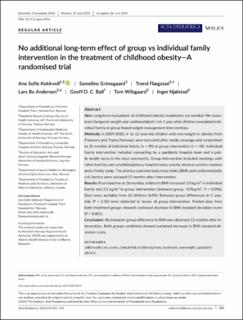| dc.contributor.author | Kokkvoll, Ane Sofie | |
| dc.contributor.author | Grimsgaard, Sameline | |
| dc.contributor.author | Flægstad, Trond | |
| dc.contributor.author | Andersen, Lars Bo | |
| dc.contributor.author | Ball, Geoff | |
| dc.contributor.author | Wilsgaard, Tom | |
| dc.contributor.author | Njølstad, Inger | |
| dc.date.accessioned | 2020-05-12T09:18:15Z | |
| dc.date.available | 2020-05-12T09:18:15Z | |
| dc.date.created | 2020-01-02T14:36:25Z | |
| dc.date.issued | 2019 | |
| dc.identifier.citation | Acta Paediatrica. 2019, 109(1), 183-192. | en_US |
| dc.identifier.issn | 0803-5253 | |
| dc.identifier.uri | https://hdl.handle.net/11250/2654030 | |
| dc.description | This is an open access article under the terms of the Creative Commons Attribution‐NonCommercial‐NoDerivs License, which permits use and distribution in any medium, provided the original work is properly cited, the use is non‐commercial and no modifications or adaptations are made. | en_US |
| dc.description.abstract | Aim: Long‐term evaluations of childhood obesity treatments are needed. We examined changes in weight and cardiometabolic risk 1 year after children completed individual family or group‐based weight management interventions.
Methods: In 2009‐2010, 6‐ to 12‐year‐old children with overweight or obesity from Finnmark and Troms (Norway) were recruited after media coverage and randomised to 24 months of individual family (n = 49) or group intervention (n = 48). Individual family intervention included counselling by a paediatric hospital team and a public health nurse in the local community. Group intervention included meetings with other families and a multidisciplinary hospital team, weekly physical activity sessions and a family camp. The primary outcome body mass index (BMI) and cardiometabolic risk factors were analysed 12 months after intervention.
Results: From baseline to 36 months, children's BMI increased 3.0 kg/m2 in individual family and 2.1 kg/m2 in group intervention (between‐group −0.9kg/m2, P = 0.096). Data were available from 62 children (64%). Between‐group differences in C peptide (P = 0.01) were detected in favour of group intervention. Pooled data from both treatment groups showed continued decrease in BMI standard deviation score (P < 0.001).
Conclusion: No between‐group difference in BMI was observed 12 months after intervention. Both groups combined showed sustained decrease in BMI standard deviation score. | en_US |
| dc.language.iso | eng | en_US |
| dc.subject | child healthcare centre | en_US |
| dc.subject | clinical trial | en_US |
| dc.subject | multidisciplinary treatment | en_US |
| dc.subject | overweight | en_US |
| dc.subject | pediatric obesity | en_US |
| dc.title | No additional long-term effect of group vs individual family intervention in the treatment of childhood obesity. A randomised trial | en_US |
| dc.type | Peer reviewed | en_US |
| dc.type | Journal article | en_US |
| dc.description.version | publishedVersion | en_US |
| dc.rights.holder | © 2019 The Authors. | en_US |
| dc.source.pagenumber | 183-192 | en_US |
| dc.source.volume | 109 | en_US |
| dc.source.journal | Acta Paediatrica | en_US |
| dc.source.issue | 1 | en_US |
| dc.identifier.doi | 10.1111/apa.14916 | |
| dc.identifier.cristin | 1765359 | |
| dc.description.localcode | Seksjon for idrettsmedisinske fag / Department of Sports Medicine | en_US |
| cristin.unitcode | 150,34,0,0 | |
| cristin.unitname | Seksjon for idrettsmedisinske fag | |
| cristin.ispublished | true | |
| cristin.fulltext | original | |
| cristin.qualitycode | 1 | |
